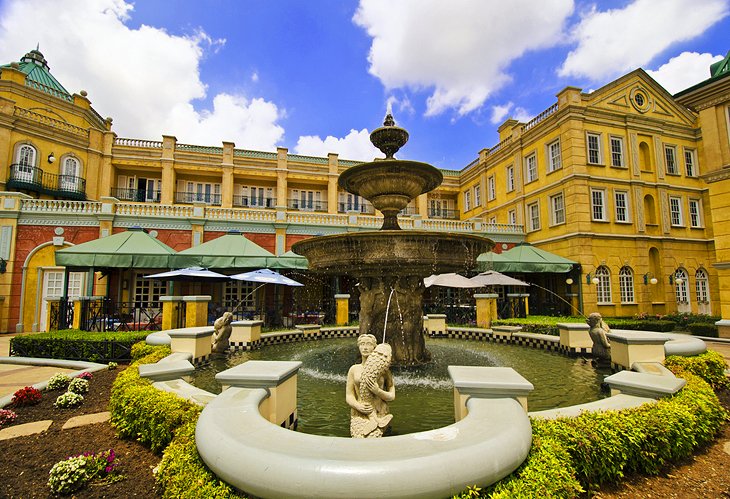The Only Guide for Johannesburg North Attractions
Things about Johannesburg North Attractions
Table of ContentsThe Best Strategy To Use For Johannesburg North AttractionsHow Johannesburg North Attractions can Save You Time, Stress, and Money.The 10-Minute Rule for Johannesburg North AttractionsJohannesburg North Attractions Can Be Fun For AnyoneJohannesburg North Attractions for DummiesThe Best Strategy To Use For Johannesburg North Attractions
The city owes its location to the presence of an also extra valuable source: gold. The city grew on the side of the Witwatersrand Key Reef, a subterranean stratum of gold-bearing quartz-silica conglomerate that arcs for hundreds of miles beneath the Highveld. The majority of the gold mines in the city stopped operation in the 1970s, but in its day the Witwatersrand gold sector represented greater than 40 percent of the world's annual gold manufacturing.Johannesburg has a pleasant climate. Summertime temperature levels average concerning 75 F (24 C); winter months temperature levels average concerning 55 F (13 C) and only periodically dip below freezing. The city appreciates regarding 8 hours of sunlight daily in both winter season and summer. Rain standards regarding 28 inches (700 millimetres) per year, however the complete differs considerably from year to year.
What rainfall the city receives falls nearly specifically in the summer months, commonly in stunning late-afternoon electrical storms., where lots of homeowners still rely on coal for fuel.

The Facts About Johannesburg North Attractions Revealed
The balance of the city is occupied by whites. Lodging differs in personality and quality.
Physical development, although rather restricted by transport, proceeded swiftly as migration to South Africa, and Johannesburg in certain, raised significantly.
The majority of inadequate residential areas were blended, with poor blacks and whites living together, although the well-off suburban areas were typically reserved for whites. This transformed with the political election of the National Party in the 1948 political elections, that began to formalise the system referred to as racism. Apartheid officially marked which suburban areas each race might live in under the Group Locations Act.
The approximated populace of the region is 200,000, [] yet the number of individuals living in the central city on a casual basis is unknown, as lots of are illegal immigrants. A lot of higher-income homeowners and white people have relocated to the north suburbs and have been changed by lower-income black individuals. The unemployment, education, and age accounts of the location are all unidentified, due to the problem of getting reputable details concerning the area.
Not known Details About Johannesburg North Attractions
Yeoville and Bellevue have a mix of house buildings and solitary property systems on small whole lots. The area lies this contact form on a hilly divide that ranges from east to west. One of the most noticeable geographic attribute is Observatory Ridge, which is called for the large observatory situated on it. The leisure spaces are no much longer utilized, as a result of protection issues.

The 3-Minute Rule for Johannesburg North Attractions
The eastern suburban areas are some of the earliest areas of Johannesburg, there are huge neighborhoods of Jewish and various other European backgrounds, the bulk of the population is English talking. There are three golf training courses as well as a number of secured ridges with viewsites.
The area is mainly composed of old "matchbox" homes, or four-room houses developed by the government, that were developed to provide inexpensive holiday accommodation for black workers throughout racism. Soweto is an abbreviation, representing "South Western Townships". Street after road in this field is lined with matchboxes; nevertheless, there are a few smaller locations where prosperous Sowetans have actually constructed houses that are extra similar in stature with those in more wealthy suburbs.
Hostels are one more noticeable physical feature of Soweto. Originally constructed to house male migrant workers, lots of have actually been improved as houses for pairs and web households. The N1 Western Bypass skirts the eastern limit of Soweto. The suburban area was not traditionally allowed to produce employment centres within the area, so nearly all of its citizens are commuters to other components of the city.
Some Known Incorrect Statements About Johannesburg North Attractions
The N1 Western Bypass links the learn the facts here now northern suburban areas with the north-western suburban areas. The domestic areas in the north suburban areas are primarily formal, with no substantial locations of informal real estate, or real estate that lacks a permanent framework. This is a well-known area, there is a trend of land usage change from household to industrial, especially along major arterial roads and around well-known nodes.
The area is well linked to road networks, particularly along the north-south axis created by the M1 and N1. Roads to the east and west are much less well established, as there are no highways travelling because instructions. Towards the northern boundary of the city, the thickness of development reduces, leaving huge locations of undeveloped land around Midrand.
Johannesburg North Attractions - The Facts
, which is situated on a hillside ignoring the inner city and Hillbrow.